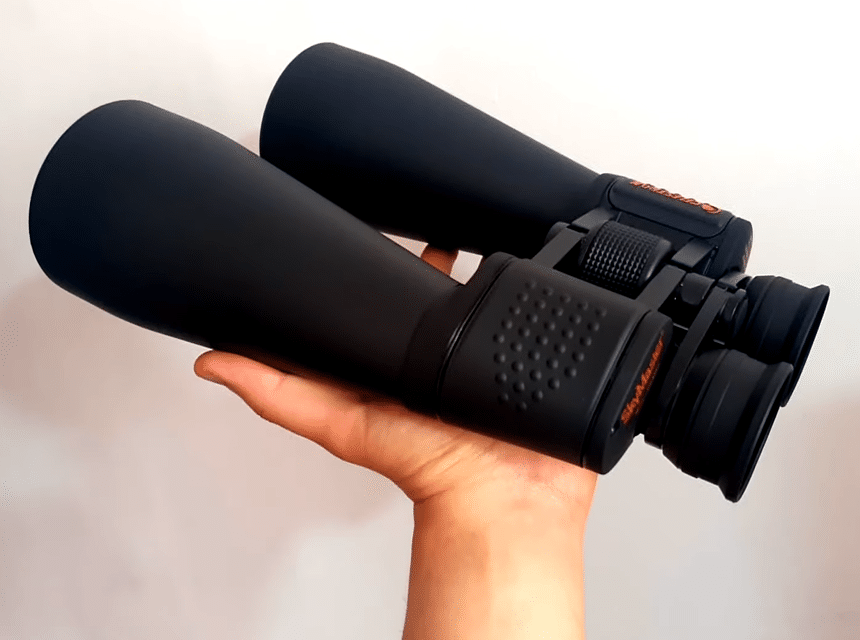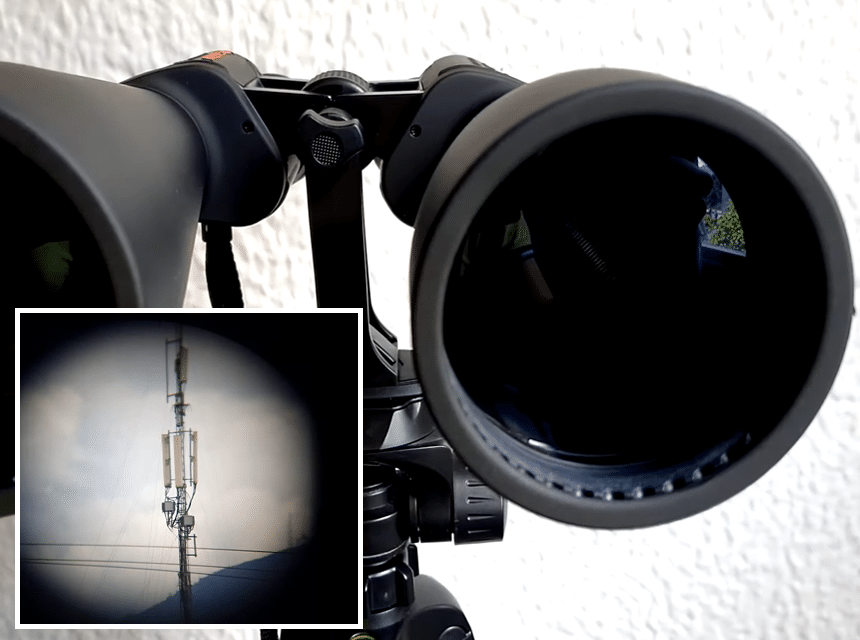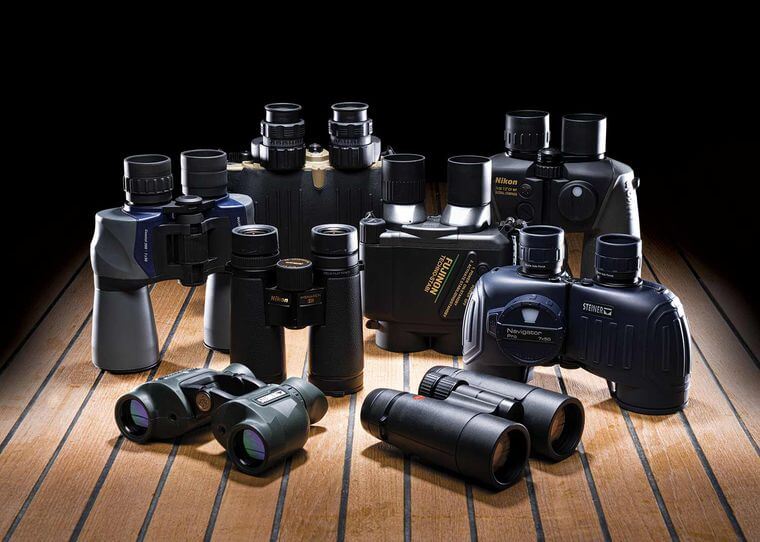













The Сelestron Skymaster 25×70 is a fairly large pair of long-distance binos. However, it’s also smaller and cheaper than most similarly designed long-distance binoculars, especially with the sub-$100 price point. This makes a Сelestron Skymaster 25×70 Review necessary as buyers want to know what value they would be getting from the device and whether they would be better off saving more for their binoculars purchase instead. Like all other binos, there are some major positives and negatives, and we focus on these in the sections below and can therefore help you figure out whether the Сelestron Skymaster 25×70 is worth your money.
As mentioned above, the Сelestron Skymaster 25×70’s are long-distance binos, and there are a couple of tell-tale signs for this even before you get the gadget in your hands. Examples include the objective lens diameter and magnification. That said, you can only judge the binos based on how well they do what they’re supposed to, which we look into in the sections below.

In terms of overall performance for the Сelestron Skymaster 25×70, there’s not much to complain about. The large objectives collect enough light for viewing distant objects. This is especially true in bright conditions, although visibility may reduce in the dark due to a small exit pupil and pupil dilation in the user.
Notably, even with limited light in the vicinity, the binos are still good enough for observing the night sky with a specific focus on larger celestial objects such as the moon and some of the more visible planets. As such, this pair of binos is excellent as an alternative to low-power telescopes that saves you money. That said, you may need to add a tripod to make full use of the binos in some of these dark settings or for observing the sky.
Additionally, they’re great for normal daytime long-distance viewing, such as in-game parks when your pupils are constricted, and you can make full use of the exit pupil in the binos.
Design-wise, these binos feature Porro-prism internal construction. According to Britannica Trusted Source Porro prism | optics | Britannica Other articles where Porro prism is discussed: prism: The Porro prism, for example, consists of two prisms arranged both to invert and to reverse an image and are used in many optical viewing instruments, such as periscopes, binoculars, and monoculars. The Nicol prism consists of two specially cut calcite prisms bonded together with an… www.britannica.com , this design incorporates two prisms that invert and reverse the images in your field of view. This means light travels in a zigzag before eventually arriving at the exit pupil, and this light path often translates to a bulkier and wider binoculars design.
The same is true for the Сelestron Skymaster 25×70’s as they’re quite chunky, especially when combined with the 70mm objectives that overall require longer barrels. The chassis is fully covered with smooth rubber, which gives the binos some shock absorption features.
Additionally, the grip is textured, so your hands don’t slip and is complimented by thumb indents for better balance when you’re holding the binos. Another element is the metal bridges and large 33mm focus wheel.
Buyers also get soft rubber eyecups with 13mm eye relief which is more than acceptable for most people who wear glasses. However, there are still some who’ll find this eye relief insufficient.
Next is the interpupillary distance range of between 5.6 and 7.2cm that caters to quite a large portion of the population. There is even a tripod mount if you want more stability for the images you’re observing.
Overall, the binos are pretty bulky and front-heavy, but they should feel quite balanced if you hold them the right way. Also, the option of using a tripod, so you don’t have to bear their weight for long periods, is also there.
Regarding the optics of the Сelestron Skymaster 25×70, they include the Porro prism. As such, the manufacturer can avoid using phase correction coating, which can be expensive. Additionally, these binos use Bak-4 glass, which has a higher refractive index than BK-7 or K9 glass.
Notably, Science ABC Trusted Source Index of Refraction: Definition, Formula, Example and a Brief Explanation The index of refraction, or refractive index, is a measure of how fast light rays travel through a given medium. Alternatively, it could be said that the refractive index is the measure of the bending of a light ray when passing from one medium to another. www.scienceabc.com describes the refractive index as how fast light travels through the glass or other mediums that transmit light. As such, a higher refractive index means faster light transference.
There’s also the element of the large 70mm objectives, which allow more light into the binos hence the higher visibility at long distances. Lastly, the Skymaster 25×70 features multi-coated glass components, which go a long way to enhance light transmittance through the ocular lenses.

As for the image quality, the multi-coated optics do their job well, and so does the overall design of the binos. Consequently, you get great image contrast, especially in brightly lit situations. There is minimal color fringing and image softening, and finally, the depth of field is decent. That said, the contrast might dip a bit in darker situations due to the dilation of your pupils, but it’s still good enough to work with.
Ultimately, there’s nothing exceptional about the image quality, but there’s nothing bad about it either. That said, for the price of these binos, in addition to how far they let you see, not many people will complain.
There’s a smooth protective rubber coating on most of the body of the Сelestron Skymaster 25×70 binoculars. This is in addition to a rubber textured grip to keep the binos from slipping out of your hands. There are also the metal components we mentioned above. Overall, the binos feel pretty solid and seem like they can handle vigorous use.
As for the weather resistance, they may be water-resistant but won’t be of much use in foggy conditions.
Buyers of these binos may also get accessories, e.g., a neck strap, carry case, and protective lens covers. These make it easier to use and transport the gadgets, therefore, adding value to the binos.
As far as the pricing for long-distance binoculars goes, the Сelestron Skymaster 25×70 binos are reasonably affordable and offer excellent value for the money. As such, if your budget is $100, there’s no reason not to go for them.
Of course, there are some extra features as well, e.g., the 23mm ocular lenses, 141 ft at 1000 yds, 2.7 degrees field of view, and 75 ft minimum focusing distance. For some, the field of view may be too small or the minimum focusing distance too large, so it’s important to consider these few extra features as well before deciding whether these binos are for you.
| PROS |
CONS |
|
|
When using your hands to hold the binos, you can comfortable see details of the moon in the night sky. You can also use a tripod to stabilize the binoculars, and that will give you a more stable view of deep sky objects such as planets, stars, and clusters. However, this is the limit for the binoculars, and you can’t see much else.
The Сelestron Skymaster 25×70 review above shows that these binoculars are both great value for money and affordable. As such, they make an excellent purchase for viewing long-distance objects in nature and the night sky. Nevertheless, users will need to purchase a tripod if they intend to make full use of the binos.





